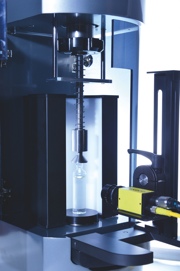Growing production capacities, complex manufacturing processes and high production speeds are changing the pharmaceutical landscape across the world. At the same time, increasingly strict safety regulations underlie the production of pharmaceuticals. They determine highest product quality to protect patients from contaminated medicine. Manufacturers are able to meet this challenge by using future-orientated inspection technologies.
Complying with strictest quality and safety regulations is particularly important for parenteral products filled in vials, ampoules, syringes and cartridges, while other liquid pharmaceuticals and solid dosage forms (tablets and capsules) must also undergo thorough inspection. Sophisticated inspection technologies are used, for instance, in the development of biotech products and anticancer treatments. They are able to evaluate processes in real time, to detect and quantify process- or component-related defects and to take corrective actions.
Product contamination occurs when particles or foreign matter are found within a medicine. Contaminated pharma ingredients, foreign matter or filling material might get into the product during manufacturing or filling operations. Cosmetic container defects, such as cracks in syringe flanges or defects in the sealing integrity of ampoules, might either already be present or occur during handling. The choice of suitable inspection technologies depends largely on product consistency, form and size of the containers. Manual, semi-automated and fully automated systems are available for either the detection of product-related contamination, cosmetic container defects or both.
Semi-automated inspection systems minimise the need for manual handling
The US Pharmacopeial Convention (USP) requires that particulate and other foreign matter visible to the human eye shall not be present.1 A human inspector can detect approximately 50% of all particles sized 50µm. He therefore physically agitates each container to set the liquid and any possible contaminants into motion, before inspecting each individual container carefully. Semi-automated inspection systems minimise the need for manual handling. The automatic feeding, sorting and discharging functions facilitate the inspectors’ work and enable them to focus on the quality control of containers.
Some automated inspection systems are able to detect particles of a size below that detectable with human capabilities. The ‘static division’ (SD) technology, for instance, projects light through the liquid onto an optical SDx sensor, leading to the differentiation of static from moving objects.
Automated camera-based systems, in turn, are used for both particle and cosmetic inspection. While the containers are agitated and rotated by more than 360°, cameras take a series of high-resolution images. By comparing these images, the system can also identify particles stuck to the sidewall, as well as crimp or sealing defects.
Integrated product quality
The Process Analytical Technology (PAT) guidance,2 issued by the US Food and Drug Administration (FDA) in 2004 triggered the development of entirely new inspection technologies, especially in the area of solid dosage forms. PAT is a system for designing, analysing and controlling manufacturing through timely measurement (i.e. during processing) of critical quality and performance attributes of raw and in-process materials and processes, with the goal of ensuring final product quality.’
The main focus of PAT is ‘building quality into products’
The main focus of PAT is ‘building quality into products’, instead of inspecting quality after the product has already been manufactured. Machines with X-ray technology, for example, are suited to this purpose. They enable comprehensive quality and weight control, for instance of capsules. New software developments and imaging capabilities contribute to a rapid advance of these technologies. Recently developed inspection units are able to check simultaneously all quality features such as weight, foreign particles, deformation of capsule top and bottom, as well as length in real-time at high throughput rates.
Combinations on the rise
Parenteral products are typically injected and go directly into the bloodstream, and therefore any adverse reaction to contamination and particles may cause serious injury. The EU Guideline to Good Manufacturing Practice (GMP), Annex 1 states that ‘filled containers of parenteral products should be inspected individually for extraneous contamination or other defects.’ It further emphasises the need for validation where other than visual inspection methods are used.

The computer-bound visual inspection unit, ETAC Easy View, examines vials, ampoules, syringes and cartridges for particle contamination and container defects
Within the validation process of fully automated inspection machines, samples are crucial to ensure that inspection machines also maintain their validated state under dynamic conditions. Manual and semi-automated inspection tools are especially suited to inspecting these samples. They are mainly used for small batch sizes, laboratory analyses, re-work of rejects, and benchmarking of fully-automated machines.
Due to the growing number of parenterals and especially generic products, manufacturers require ever faster machines for larger production quantities. Here, manual inspection is quickly stretched to its limits. Even the best-trained human inspector cannot keep up with the high speeds of all production types. Depending on the size and type of the pharmaceutical product and container, a combination of automated and manual inspection is sure to be the most reliable approach.
To ensure that inspection machines operate at their best, manufacturers need to pay attention to validation requirements and perform regular maintenance activities. They should also carefully monitor their processes and regularly check new regulations and guidelines, as well as the availability of new technologies. The possibilities of inspection technology are immense. Therefore the decision for robust and reliable technologies from suppliers is of utmost importance for high product quality and the best possible patient safety.
References
1. Michael de la Montaigne, Pedro. J. Mendez, Ryosaku Tagaya: Inspection of Parenteral Products. Davis Healthcare International, 2009.
2. http://www.boschpackaging.com/eisaimachinery/




